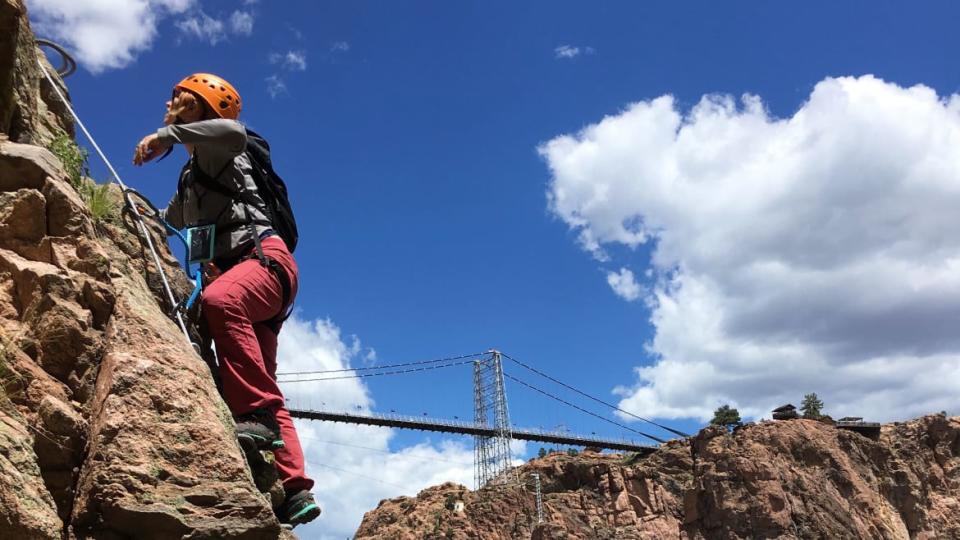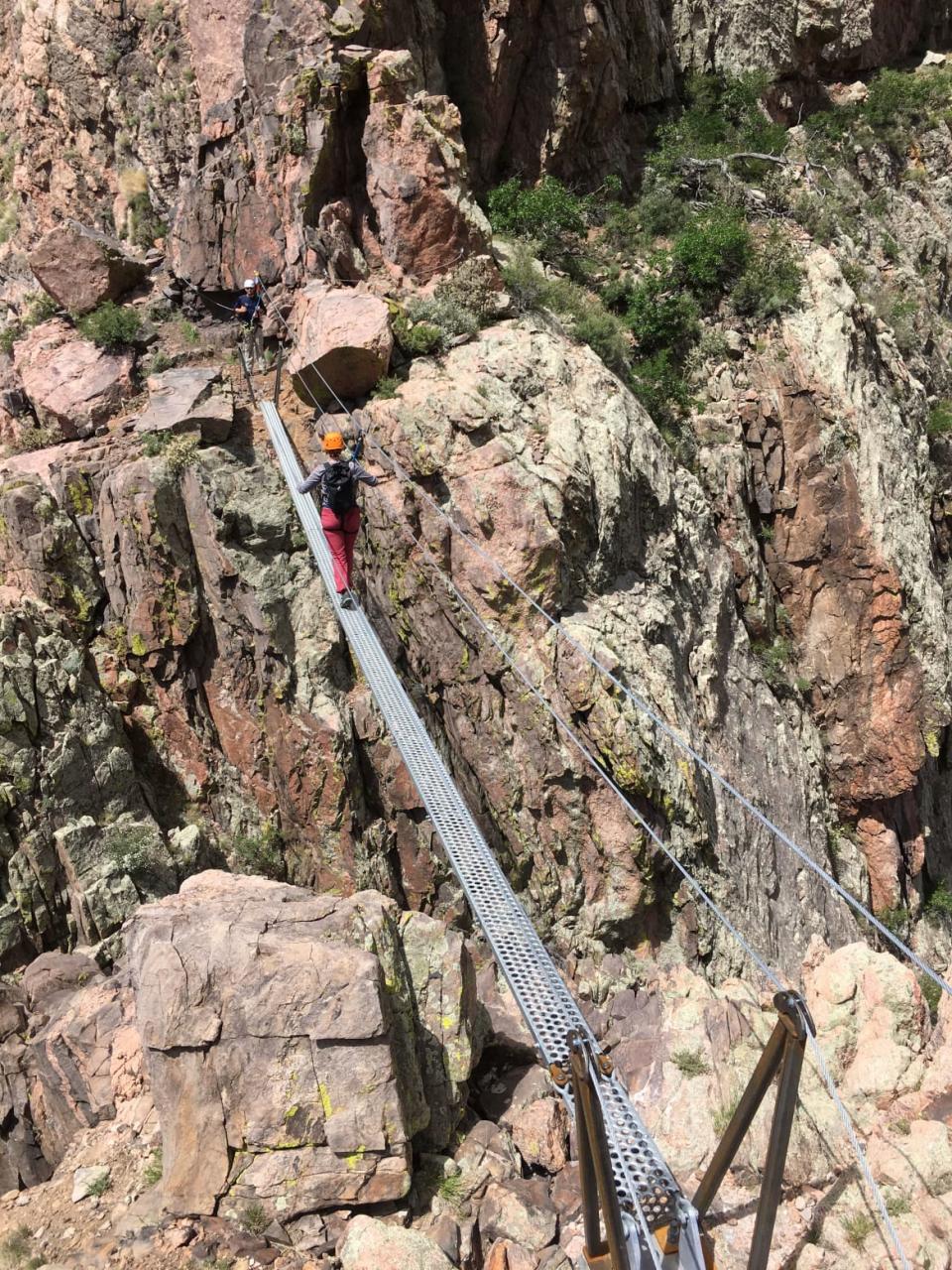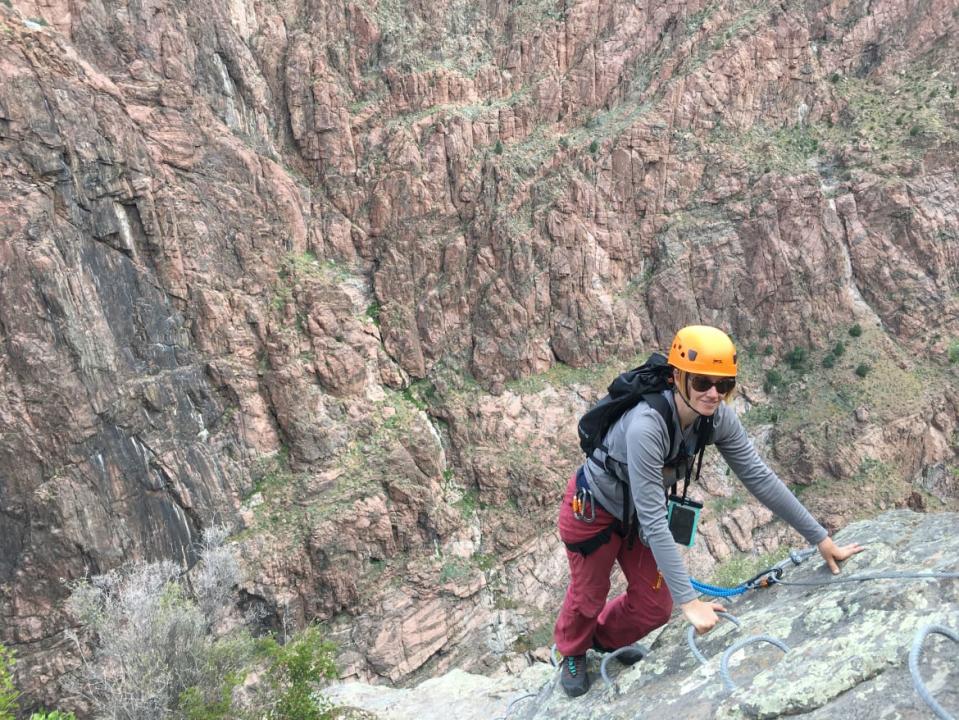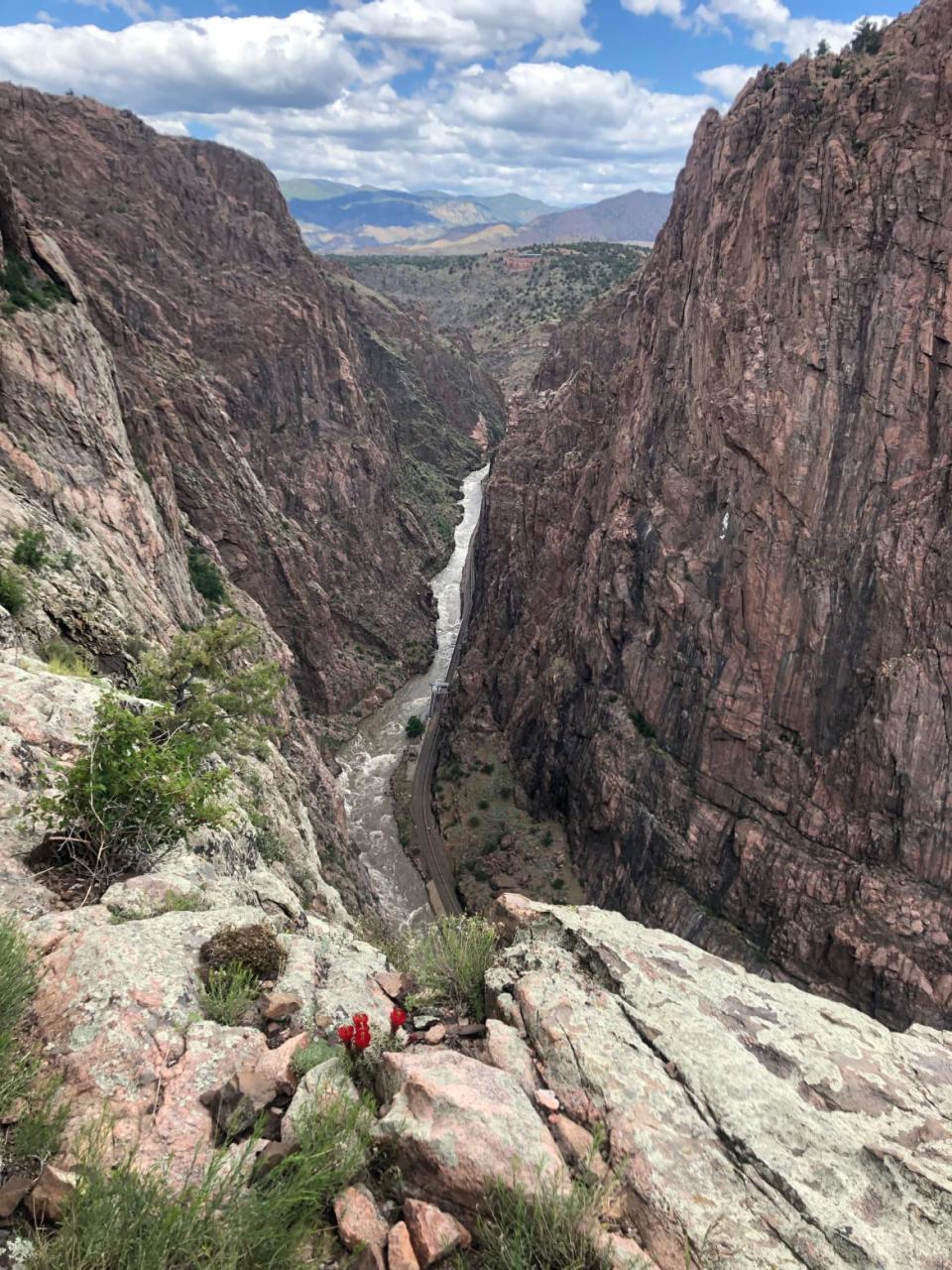You Don’t Have to Be Alex Honnold to Brave This Adventure Trend

As I prepared to step onto the aerial walkway, I double checked my two safety points—a pair of auto-locking carabiners clipped to a steel cable above my head and attached to dynamic lanyards on my harness—and reminded myself to breathe. Then, channeling all of my courage, I placed one foot in front of the other and began to cross the 56-foot strip of steel decking that connects the vermilion granite walls of Colorado’s Royal Gorge to “the Throne,” a natural spire.
The aerated metal plank is suspended about 100 feet above the narrow slab of earth where the Throne attaches to the cliff face, but, as I looked left and right, I realized I was actually perched 600 feet above the floor of the gorge and the rush of the Arkansas River. My hands tightened around the steel cables that serve as handrails and my forward momentum stalled.
I don’t know whether it’s the result of mainstream movies like Meru and Free Solo or just part of a more general booming national desire to head into extreme places where big adventures await, but the popularity of the vertical world has been growing in the US in recent years.
However, with that new and commendable passion for the outdoors comes overcrowding on mountain ascents and outdoor crags, and a rising concern that inexperienced climbers are taking on too much in search of a thrill, not to mention the ultimate Instagram photo.
Enter the via ferrata, Italian for “iron way” or “iron road.” These fixed routes composed of iron rungs, steel cables, and sometimes heart-stopping aerial walkways originated in the Dolomites more than 100 years ago as a way for soldiers and suppliers to move through the mountains. They’ve since become a way for fit adventurous types who lack (or don’t) the technical climbing skills to experience Europe’s alpine regions. And in the last decade, the trend has taken off on this side of the Atlantic.

Ten years ago, just a handful of via ferratas laced the mountains of North America, and many of them (Telluride!) were still intended for climbers who already possessed knowledge and gear. But more recently, things have changed, and the routes are giving the uninitiated safe access to the splendors of the vertical world. In 2018 alone, Mammoth Lakes, Squaw Valley, Colorado Springs, and Buena Vista all introduced routes. When the Royal Gorge Bridge and Park opened its version in May 2019, it became the fifth in Colorado.
Buoyed by encouragement from my husband and our guide, I continued across the aerial walkway. As I stepped onto the solid rock of the Throne, I grinned and squealed in relief and delight. “I cannot believe I just did that!”
Once I had transferred my lanyards from the cable above the walkway to the one bolted to the spire, my husband clipped in and sauntered easily across. I stayed plastered to my little patch of rock—still reminding myself to breathe—as he joined the guide to snatch a one-of-a-kind view of the gorge, teetering over the edge of the spire (still attached to the steel cables).
And that’s the thing about via ferratas. As an experienced but timid rock climber, I had been wary of the trend, suspecting it was for adrenaline fiends who didn’t want to learn the skills of rope management or free climbing (the art of ascending using holds on the rock rather than aids; not to be confused with free soloing or soloing). But the design of the course—with five routes accessible with a guide to the general public, and an optional detour to the aerial walkway—allows a striking range of individuals to get something out of their experience. Plus, it’s fun.

“When we were deciding on a new attraction… first, we wanted something that families and friends can accomplish together. We love the idea that parents and their kids, grandparents and their grandchildren, and adventure seekers of all different skill levels can create memories here doing something that is safe yet very adventurous. The via ferrata is truly a ‘fun for all ages’ type of attraction,” says Brent Hargrave, chief operating officer of the Royal Gorge Bridge and Park.
To accommodate climbers age 12 and up and of all skill levels, the experience starts with a short downhill hike to a pair of routes that meander up a gentle slab. These warm-ups also provided a chance to familiarize ourselves with the style of climbing and the gear. Even for rock climbers or mountaineers this is important, since it’s different from what they’re likely used to. Iron rungs stick out from the rock, serving as hand and footholds. A steel cable runs parallel to the route, attached to the wall every five to 15 feet and as climbers move along, they slide their lanyards along the segments, transferring one carabiner at a time to the next section of cable at the attachment points. The Royal Gorge Bridge and Park provides via ferrata climbers with helmets, approach shoes, a small backpack, and a harness with two safety lanyards.
Once our guide was satisfied we were climbing safely and we confirmed our desire to move on, we hiked downward to access the rest of the routes. As we switchbacked through the high desert, and skirted the cliff’s edge, I paused to snap photos of silky scarlet barrel cactus blooms and kept my eyes peeled for the feisty antics of big horn sheep or mountain goats. None graced our little group with their presence, but they’re always a possibility in these parts. Roughly halfway through, we came upon the option of the aerial walkway, a must for guests looking for epic views, heart-stopping thrills, or a chance to test their own mental mettle.

But the magic came near the end of our almost five-hour adventure. Spanning the void at nearly 1,000 feet above the Arkansas River, the Royal Gorge Bridge was the world’s highest suspension bridge from its construction in 1929 until 2001. And there we were, balanced on a narrow trail along the edge of a cliff, almost eye-level with that gravity-defying bridge, engaging with nature and ourselves in a new way. For our second-to-last climb, we had a choice to make. Shimmy up a fun route tucked into a nook, or ascend a protruding corner where the wall disappears on either side. The former would feel safer. The latter would force me to face that fear of heights again. Feeling confident after conquering the aerial walkway, I opted for the exposed route. I wanted to keep pushing myself, and I wanted a chance at that view.
“For decades, visitors have been viewing the Royal Gorge from above and below,” says Hargrave. The via ferrata changes that. Since it opened in late spring, tours have been booked almost every day, as visitors look for a new way to interact with the region. And with multiple established routes and more under development, the experience has considerable replay value. I’ll certainly be back.
Get our top stories in your inbox every day. Sign up now!
Daily Beast Membership: Beast Inside goes deeper on the stories that matter to you. Learn more.
